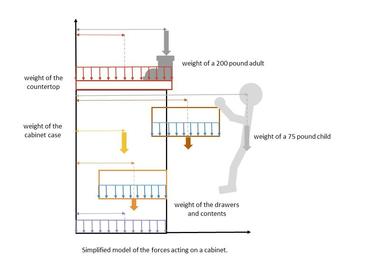Bathroom vanities that rest on the floor is SO 2010. Trending now are vanities mounted on the wall – especially in hotels. It’s a great look, but it brought up some testing questions for the Kitchen Cabinet Manufacturing Association that certifies cabinet performance.
What happens if a young child climbs up on the drawers? What if an adult stands on it to reach something? Can it meet the same standards as floor cabinets?
A NRRI team approach to addressing the KCMA’s questions resulted in a report that outlined current options on the market, potential stresses and testing results.
Patrick Donahue, NRRI Building Materials Program manager, had heard through his national network in the cabinet industry about the challenges with wall hung cabinets meeting specifications for weight.
“We have the wood products expertise, cabinet testing capabilities and engineering to pull together a comprehensive study for them,” said Donahue. “So that’s what we did.”

First, the team had to know what’s out there – the different shapes, sizes and mounting systems in use. NRRI student technician Kamryn Kalal searched the internet for product examples, how they’re built and types of brackets used.
“Then we brainstormed worst-case scenarios involving cabinet installation, use and abuse,” said Victor Krause, NRRI wood products scientist. NRRI Engineer Kory Jenkins diagramed the testing protocol.
They received 10 different cabinets from four different companies for testing against the KCMA’s current cabinet standards. They mounted them – one by one – upside down on a test wall and turned on the pressure.
A hydraulic press was used to apply loads at a rate of about 150 pounds-per-minute, taking four minutes to reach a 600 pound load, which is the KCMA standard. They kept applying pressure until something broke.
The final report, delivered in January, gives the cabinet association the formulas they need to make calculated decisions for certification of wall-mounted cabinets.
“We’re hoping that by demonstrating our capabilities for product testing, we’ll attract more opportunities for expanded testing or some research projects, maybe on new, lighter materials or stronger adhesives,” said Krause.
